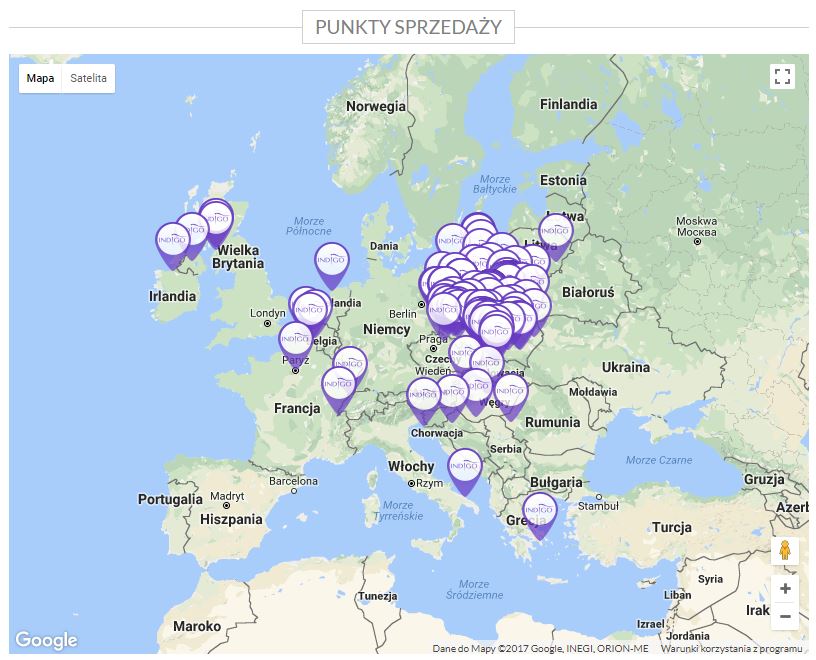Dynamic changes that go through economic, technological, political and social sphere (globalization of media, human migrations, technological progress, universalistic values, culture, fashion, and lifestyle) provide a fertile ground for brands that want to expand into foreign markets. Both big corporate entities and small business should use the opportunity and evaluate the competition not only on local but also international scale.
Global potential
Since early stages of development, Indigo brand hand a vision of operating in the international context. Quickly the company took steps to develop a distribution network and to build brand visibility abroad. At this point, Indigo has distribution points in 24 counties – most of Middle-Eastern Europe, Canada, RSA and five states of Australia. You can see it on the map below. The distribution network is still in development.

Indigo brand has everything a company needs to achieve international success. First of all, a universal, easy to pronounce name which is a bow to the idea behind the company – colours and pigments and it doesn’t have any negative connotations. Second of all, it has a functional, timeless logo which sets it apart from others in the industry and is simple at the same time. It complements the name perfectly and adds some character, the identifiable wave above the “i” clearly, but do not literally refers the act of painting nails. Moreover, the production of amazing, outstanding products that have English names. The colour spectrum of Indigo gel polishes is impressive and so rich that women in any part of the world will find their
Favourite shades. Different colours are liked in different countries – Italian women love sparkle and vibrant colours, French adore nude shades. Not only colours grab attention but funny, quirky names also are easy to remember.
With an international market in mind, a website was created in Polish and English language version. There you’ll find our products with photos and description. Our marketing materials can also be prepared in a number of languages.
Global thinking, local acting
Creating a brand with an international range is a hard, costly and time-consuming task. The biggest challenge is finding the best brand promotion strategy which has to be different for each country. With a “global thinking, local acting” motto in mind, each tiny of the strategy detail must be tailored to the needs and specification of country’s market.
To avoid mistakes and drowning an unnecessary sum of money you need to take into consideration different conditions, especially social and cultural as well as legal. The most important are the language differences. The name of the brand and products, as well as marketing slogans, need to be carefully constructed with the way they sound, what they mean and what are the associations in mind. Often with an expansion to foreign market comes need to change the name. When choosing the name it’s important to pick words that do not carry a lot of information, do not have an emotional baggage and are short, nice to heat and easy to say by foreign speakers. Any co notations with religion, tradition and local culture should also be avoided.
Creating marketing campaigns targeted for foreign market means you need to take into consideration not only language but also differences in lifestyle system of value and even the climate, all these elements create client’s preference. Choosing the right colours is very important since colours can carry different meaning and associations in different countries. This needs to be taken into consideration when designing a logo and other graphics.
Positioning of a brand = success on international arena
Entering the international market demands adjusting things like the offer, and marketing tools to the specifics of the particular country, one of the most important and eye-catching element are the brand itself. Brand, that identifies the services the company provides and sets it apart from the competition but more importantly evoke specific feelings and associations that encourage the client to buy and creates a lasting reputation.
The intangible power of the brand comes from the fact that it targets people’s minds. But the image and the association’s people have with the brand may differ from country to country. This is why the identity of the brand (the way the brand is supposed to be seen) should be carefully tailored to each market.
The brand can be positioned at a different angle but not every way will work in the international market. The positioning based on the product’s parameters is very popular but yields best results on a local or national market. The same is with the aspirational positioning which demands to create a well defined, specific persona (like a modern, active woman) – this strategy demands to create a very precise image of the client existing in a specific market. A brand can be positioned by appealing to a famous person that is a brand’s ambassador. Key here is a right choice of the celebrity that needs to be not only known in the country but also be associated with positive emotions and likes. Only then we can assume that positive opinions and connotations will be transferred on the brand they represent.
Brans as a lasting, positive image of the products that exist in the mind of the consumer is a very powerful marketing tool that plays a key role in the expansion to the foreign counties. The identity of the brand has many components like name, logo, packaging advertising style product characteristics and brand associations. The connotations are connected not only to the properties of the product (functionality durability) but also social and psychological aspects (prestige, modernity, ennoblement, belonging to a given class). To help the brand arise in the international market it needs to be associated positively in different parts of the world and that means following the rule: “think globally, act locally”
 English
English Polski
Polski